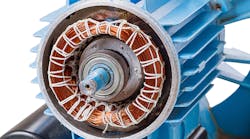Electric motors are incredibly common in manufacturing and many engineers are well-versed in their operation and principles. But the average consumer, and even a few non-electrical engineers are unaware that what they think is true about motors and efficiency just isn’t true. Here are five of the more common myths about motors.
1. Higher temperatures have little effect on electric motors. Properly designed motors fall into specific insulation classes. The class determines the motor’s maximum operating ambient temperature rating. That rating, which includes some level of load, accounts for the threshold temperature the motor should remain beneath. For each 18°F this threshold is exceeded, the motor’s life is cut in half.â
2. Frequent startups do not hurt a motor. If a motor is not designed for frequent starts, then subjecting it to them will shorten its operational life. The initial rush of starting current generates extra heat, which usually dissipates while the motor runs. But if the motor does not run long enough between starts, there’s no time to shed the extra heat and the motor could exceed its maximum operating temperature.
3. Power-factor corrections save a lot of energy. Power-factor correction can reduce energy use, but only by a small amount. So unless your utility requires power-factor correction or charges penalties for low power factors, improving it will not affect your electric bill. The amount of energy saved depends on several site-specific factors, including the mix of electrical loads connected to your meter, the type and length of conductors, and where power-factor-correction equipment is placed (i.e., closer to the meter or closer to the motor loads). However, even in extreme cases, it is unusual for electrical consumption savings to be greater than 2%.
4. High-efficiency motors save more energy than standard-efficiency motors. In fact, an induction motor’s operating speed is somewhat less than its synchronous speed. The motor turns at the synchronous speed if the motor shaft’s rotation matches the frequency of the ac electricity powering the motor. The difference between synchronous and actual speed is called “slip.” Many energy-efficient motors operate with less full-load slip or at slightly higher speeds than comparably sized efficiency motors.
For centrifugal fans and pumps, even minor changes in a motor’s operating speed translate into a major change in the imposed load and annual energy consumption. Fan and pump “affinity” laws indicate that horsepower loading on motors by centrifugal loads varies as the third power or cube of its rotational speed. So a small increase in motor speed of 20 rpm can cause a 3.5% increase in electrical load.
5. Soft-start equipment on big electrical motors cuts utility demand charges. Soft-start equipment can lower your utility bills, but it will not significantly reduce demand charges. When motors start, they draw an “inrush” of current, often five to six times the motor’s full-load running current. This creates heat, a motor’s enemy. Soft starters increase the voltage applied to motor terminals over time, and this limits the inrush current and reduces heat buildup. In doing so, soft starters extend motor lifetimes, in particular, for motors frequently stopped and started.
Demand charges from utilities, however, are not affected. If electrical kilowatt demand is measured and billed on your utility account, the electric meter measures the average kW consumed over each 15 or 30-minute period. In contrast, soft starters affect motors’ power draw over the course of just a few seconds. The motor’s lower power draw over that short period is insignificant compared to the time period when demand charges are calculated.

